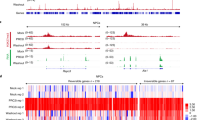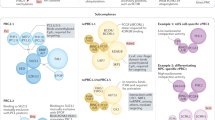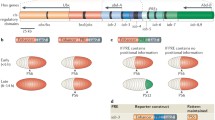Abstract
For mammals to develop properly, master regulatory genes must be repressed appropriately in a heritable manner. This review concerns the Polycomb Repressive Complex 1 (PRC1) family and the relationship between the establishment of repression and memory of the repressed state. The primary focus is on the CBX family of proteins in PRC1 complexes and their role in both chromatin compaction and phase separation. These two activities are linked and might contribute to both repression and memory.




Similar content being viewed by others
References
Beh LY, Colwell LJ and Francis NJ 2012 A core subunit of Polycomb repressive complex 1 is broadly conserved in function but not primary sequence. Proc. Natl. Acad. Sci. USA 109 E1063–1071
Boettiger AN, Bintu B, Moffitt JR, Wang S, Beliveau BJ, Fudenberg G, Imakaev M, Mirny LA, Wu CT and Zhuang X 2016 Super-resolution imaging reveals distinct chromatin folding for different epigenetic states. Nature 529 418–422
Chen Q, Huang L, Pan D, Zhu LJ and Wang YX 2018 Cbx4 sumoylates Prdm16 to regulate adipose tissue thermogenesis. Cell Rep. 22 2860–2872
Chung CY, Sun Z, Mullokandov G, Bosch A, Qadeer ZA, Cihan E, Rapp Z, Parsons R, Aguirre-Ghiso JA, Farias EF, et al. 2016 Cbx8 acts non-canonically with Wdr5 to promote mammary tumorigenesis. Cell Rep. 16 472–486
Core N, Bel S, Gaunt SJ, Aurrand-Lions M, Pearce J, Fisher A and Djabali M 1997 Altered cellular proliferation and mesoderm patterning in Polycomb-M33-deficient mice. Development 124 721–729
Dietrich N, Bracken AP, Trinh E, Schjerling CK, Koseki H, Rappsilber J, Helin K and Hansen KH 2007 Bypass of senescence by the polycomb group protein CBX8 through direct binding to the INK4A-ARF locus. EMBO J. 26 1637–1648
Ferrari KJ, Scelfo A, Jammula S, Cuomo A, Barozzi I, Stutzer A, Fischle W, Bonaldi T and Pasini D 2014 Polycomb-dependent H3K27me1 and H3K27me2 regulate active transcription and enhancer fidelity. Mol. Cell. 53 49–62
Fischle W, Wang Y, Jacobs SA, Kim Y, Allis CD and Khorasanizadeh S 2003 Molecular basis for the discrimination of repressive methyl-lysine marks in histone H3 by Polycomb and HP1 chromodomains. Genes Dev. 17 1870–1881
Francis NJ, Kingston RE and Woodcock CL 2004 Chromatin compaction by a polycomb group protein complex. Science 306 1574–1577
Gao Z, Zhang J, Bonasio R, Strino F, Sawai A, Parisi F, Kluger Y and Reinberg D 2012 PCGF homologs, CBX proteins and RYBP define functionally distinct PRC1 family complexes. Mol. Cell 45 344–356
Grau DJ, Chapman BA, Garlick JD, Borowsky M, Francis NJ and Kingston RE 2011 Compaction of chromatin by diverse Polycomb group proteins requires localized regions of high charge. Genes Dev. 25 2210–2221
Ismail IH, Gagne JP, Caron MC, McDonald D, Xu Z, Masson JY, Poirier GG and Hendzel MJ 2012 CBX4-mediated SUMO modification regulates BMI1 recruitment at sites of DNA damage. Nucleic Acids Res. 40 5497–5510
Isono K, Endo TA, Ku M, Yamada D, Suzuki R, Sharif J, Ishikura T, Toyoda T, Bernstein BE and Koseki H 2013 SAM domain polymerization links subnuclear clustering of PRC1 to gene silencing. Dev. Cell 26 565–577
Kagey MH, Melhuish TA and Wotton D 2003 The polycomb protein Pc2 is a SUMO E3. Cell 113 127–137
Kalb R, Latwiel S, Baymaz HI, Jansen PW, Muller CW, Vermeulen M and Muller J 2014 Histone H2A monoubiquitination promotes histone H3 methylation in Polycomb repression. Nat. Struct. Mol. Biol. 21 569–571
Katoh-Fukui Y, Baba T, Sato T, Otake H, Nagakui-Noguchi Y, Shindo M, Suyama M, Ohkawa Y, Tsumura H, Morohashi KI, et al. 2019 Mouse polycomb group gene Cbx2 promotes osteoblastic but suppresses adipogenic differentiation in postnatal long bones. Bone 120 219–231
Katoh-Fukui Y, Owaki A, Toyama Y, Kusaka M, Shinohara Y, Maekawa M, Toshimori K and Morohashi K 2005 Mouse Polycomb M33 is required for splenic vascular and adrenal gland formation through regulating Ad4BP/SF1 expression. Blood 106 1612–1620
Katoh-Fukui Y, Tsuchiya R, Shiroishi T, Nakahara Y, Hashimoto N, Noguchi K and Higashinakagawa T 1998 Male-to-female sex reversal in M33 mutant mice. Nature 393 688–692
Kim CA, Gingery M, Pilpa RM and Bowie JU 2002 The SAM domain of polyhomeotic forms a helical polymer. Nat. Struct. Biol. 9 453–457
King IF, Emmons RB, Francis NJ, Wild B, Muller J, Kingston RE and Wu CT 2005 Analysis of a polycomb group protein defines regions that link repressive activity on nucleosomal templates to in vivo function. Mol. Cell Biol. 25 6578–6591
Kundu S, Ji F, Sunwoo H, Jain G, Lee JT, Sadreyev RI, Dekker J and Kingston RE 2017 Polycomb Repressive Complex 1 generates discrete compacted domains that change during differentiation. Mol. Cell 65 432–446 e435
Larson AG, Elnatan D, Keenen MM, Trnka MJ, Johnston JB, Burlingame AL, Agard DA, Redding S and Narlikar GJ 2017 Liquid droplet formation by HP1alpha suggests a role for phase separation in heterochromatin. Nature 547 236–240
Lau MS, Schwartz MG, Kundu S, Savol AJ, Wang PI, Marr SK, Grau DJ, Schorderet P, Sadreyev RI, Tabin CJ, et al. 2017 Mutation of a nucleosome compaction region disrupts Polycomb-mediated axial patterning. Science 355 1081–1084
Lee HG, Kahn TG, Simcox A, Schwartz YB and Pirrotta V 2015 Genome-wide activities of Polycomb complexes control pervasive transcription. Genome Res. 25 1170–1181
Liu B, Liu YF, Du YR, Mardaryev AN, Yang W, Chen H, Xu ZM, Xu CQ, Zhang XR, Botchkarev VA, et al. 2013 Cbx4 regulates the proliferation of thymic epithelial cells and thymus function. Development 140 780–788
Luis NM, Morey L, Mejetta S, Pascual G, Janich P, Kuebler B, Cozutto L, Roma G, Nascimento E, Frye M, et al. 2011 Regulation of human epidermal stem cell proliferation and senescence requires polycomb- dependent and -independent functions of Cbx4. Cell Stem Cell 9 233–246
Margueron R, Justin N, Ohno K, Sharpe ML, Son J, Drury WJ, 3rd, Voigt P, Martin SR, Taylor WR, De Marco V, et al. 2009 Role of the polycomb protein EED in the propagation of repressive histone marks. Nature 461 762–767
Min J, Zhang Y and Xu RM 2003 Structural basis for specific binding of Polycomb chromodomain to histone H3 methylated at Lys 27. Genes Dev. 17 1823–1828
Morey L, Pascual G, Cozzuto L, Roma G, Wutz A, Benitah SA and Di Croce L 2012 Nonoverlapping functions of the Polycomb group Cbx family of proteins in embryonic stem cells. Cell Stem Cell 10 47–62
O’Loghlen A, Munoz-Cabello AM, Gaspar-Maia A, Wu HA, Banito A, Kunowska N, Racek T, Pemberton HN, Beolchi P, Lavial F, et al. 2012 MicroRNA regulation of Cbx7 mediates a switch of Polycomb orthologs during ESC differentiation. Cell Stem Cell 10 33–46
Peng K, Radivojac P, Vucetic S, Dunker AK and Obradovic Z 2006 Length-dependent prediction of protein intrinsic disorder. BMC Bioinformatics 7 208
Piunti A and Shilatifard A 2016 Epigenetic balance of gene expression by Polycomb and COMPASS families. Science 352 aad9780
Plys AJ, Davis CP, Kim J, Rizki G, Keenen MM, Marr SK and Kingston RE 2019 Phase separation of Polycomb-repressive complex 1 is governed by a charged disordered region of CBX2. Genes Dev. 33 799–813
Rice P, Longden I and Bleasby A 2000 EMBOSS: the European Molecular Biology Open Software Suite. Trends Genet. 16 276–277
Santanach A, Blanco E, Jiang H, Molloy KR, Sanso M, LaCava J, Morey L and Di Croce L 2017 The Polycomb group protein CBX6 is an essential regulator of embryonic stem cell identity. Nat. Commun. 8 1235
Satijn DP, Gunster MJ, van der Vlag J, Hamer KM, Schul W, Alkema MJ, Saurin AJ, Freemont PS, van Driel R and Otte AP 1997 RING1 is associated with the polycomb group protein complex and acts as a transcriptional repressor. Mol Cell Biol. 17 4105–4113
Saurin AJ, Shiels C, Williamson J, Satijn DP, Otte AP, Sheer D and Freemont PS 1998 The human polycomb group complex associates with pericentromeric heterochromatin to form a novel nuclear domain. J. Cell Biol. 142 887–898
Schoorlemmer J, Marcos-Gutierrez C, Were F, Martinez R, Garcia E, Satijn DP, Otte AP and Vidal M 1997 Ring1A is a transcriptional repressor that interacts with the Polycomb-M33 protein and is expressed at rhombomere boundaries in the mouse hindbrain. EMBO J. 16 5930–5942
Schuettengruber B, Bourbon HM, Di Croce L and Cavalli G 2017 Genome Regulation by Polycomb and Trithorax: 70 Years and Counting. Cell 171 34–57
Strom AR, Emelyanov AV, Mir M, Fyodorov DV, Darzacq X and Karpen GH 2017 Phase separation drives heterochromatin domain formation. Nature 547 241–245
Tan J, Jones M, Koseki H, Nakayama M, Muntean AG, Maillard I and Hess JL 2011 CBX8 a polycomb group protein, is essential for MLL-AF9-induced leukemogenesis. Cancer Cell 20 563–575
Tatavosian R, Kent S, Brown K, Yao T, Duc HN, Huynh TN, Zhen CY, Ma B, Wang H and Ren X 2019 Nuclear condensates of the Polycomb protein chromobox 2 (CBX2) assemble through phase separation. J. Biol. Chem. 294 1451–1463
Wani AH, Boettiger AN, Schorderet P, Ergun A, Munger C, Sadreyev RI, Zhuang X, Kingston RE and Francis NJ 2016 Chromatin topology is coupled to Polycomb group protein subnuclear organization. Nat. Commun. 7 10291
Whitcomb SJ, Basu A, Allis CD and Bernstein E 2007 Polycomb Group proteins: an evolutionary perspective. Trends. Genet. 23 494–502
Zhu L and Brangwynne CP 2015 Nuclear bodies: the emerging biophysics of nucleoplasmic phases. Curr. Opin. Cell. Biol. 34 23–30
Acknowledgements
We thank ES Jaensch, T Oei, and AJ Plys for critical reading of the manuscript. This work was supported by the NIH grant R35GM131743 to REK and the Urology Care Foundation Research Scholar Award Program to JK.
Author information
Authors and Affiliations
Corresponding author
Additional information
This article is part of the Topical Collection: Chromatin Biology and Epigenetics.
Rights and permissions
About this article
Cite this article
Kim, J., Kingston, R.E. The CBX family of proteins in transcriptional repression and memory. J Biosci 45, 16 (2020). https://doi.org/10.1007/s12038-019-9972-5
Published:
DOI: https://doi.org/10.1007/s12038-019-9972-5




